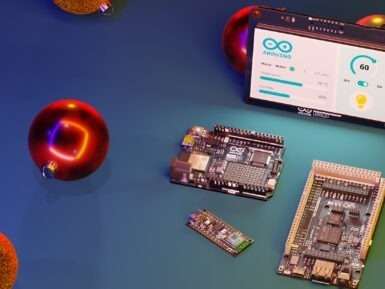
Overview
If you are experimenting with monitoring fleets, high-altitude scientific experiments, or any kind of project requiring localization of devices, the MKR GPS Shield will offer you the functionality you need, and it is plug 'n' play!
The MKR GPS Shield is based on the u-blox SAM-M8Q GNSS (Global Navigation Satellite System) module. It is meant to be used on top of boards in the MKR format, but thanks to its Eslov connector, it is also possible to hook it up to any board having that kind of connector available using a cable.
This module is designed to operate with different positioning services concurrently. It receives and processes the signals from GPS, GLONASS, and Galileo. It interfaces with Arduino boards either through a serial interface, when used with headers and put on top of a MKR board, or through an I2C interface and a dedicated ESLOV cable supplied as bundle.
Configuration Commands and Backup
The GPS module can be configured via special commands. We have included an on-board battery holder for the system to keep the configurations made via software. This can be convenient when e.g. changing the operation mode of the GPS to 1g, something common in high altitude experiments, where specific settings away from the default ones are needed for the device.
Another example is the use of Galileo's localization option, which is disabled by default, but can be enabled by sending a configuration message (UBXCFG-GNSS) to the receiver. You can find a detailed description of all of the commands in the protocol here.
Getting Started
Our Arduino_MKRGPS library handles the two different interfaces and offer a consistent set of APIs designed for a full usage of the GPS acquired information
Need Help?
Check the Arduino Forum for questions about the Arduino Language, or how to make your own Projects with Arduino. Need any help with your board please get in touch with the official Arduino User Support as explained in our Contact Us page.
Warranty
You can find here your board warranty information.
Tech specs
| GNSS receiver | u-blox module SAM-M8Q (datasheet) |
| Connectors | MKR headers / Eslov |
| Input Voltage | 3.3V |
| Operating Voltage | 3.3V |
| Backup battery | CR1216 |
| Communication | Serial / I2C / DCC |
| Length | 45 mm |
| Width | 25 mm |
| Weight | 14 gr. |
Conformities
Resources for Safety and Products
Manufacturer Information
The production information includes the address and related details of the product manufacturer.
Arduino S.r.l.
Via Andrea Appiani, 25
Monza, MB, IT, 20900
https://www.arduino.cc/
Responsible Person in the EU
An EU-based economic operator who ensures the product's compliance with the required regulations.
Arduino S.r.l.
Via Andrea Appiani, 25
Monza, MB, IT, 20900
Phone: +39 0113157477
Email: support@arduino.cc
Documentation
OSH: Schematics
The Arduino MKR GPS Shield is open-source hardware! You can build your own board using the following files:
EAGLE FILES IN .ZIP SCHEMATICS IN .PDF
Additional I2C Port
The MKR GPS Shield has an additional connector meant as an extension of the I2C bus. It's a small form factor 5-pin connector with 1.0 mm pitch. The mechanical details of the connector can be found in the connector's datasheet.
The I2C port, also referred to as the Eslov self-identification port within Arduino, comes with: SDA, SCL, GND, +5V, and an extra digital pin meant to send an alarm to the otherwise plain I2C devices connected to it. The pinout is shown in the following image:
If you are interested in designing your own modules for Arduino boards with this expansion port, the connector we suggest using is code: SHR-05V-S-B, also in the picture.
Learn more
Get Inspired

The holidays can be a great time to pick up a new passion, or start a new project! And if you are at home with friends and family, a DIY challenge can be just what you need to spend a few hours together – learning and laughing all the way. We’ve definitely kept all of this in mind while fine tuning our 2023 gift guides, full of ideas and inspiration for the special people on your list! We’re sure you’ll find something for everyone… and a treat for yourself too. Giving the gift of creativity A kit with step-by-step instructions and all the components you need can provide the perfect pastime, even with kids: you can go through the Starter Kit one project at the time to learn the basics of electronics and coding, or try your hand at IoT – it’s easy with the Arduino Oplà IoT Kit! This 8-projects-in-1-box gift allows even beginners to explore smart connectivity: anyone can have their smart lights system, personal weather station, or home security alarm ready by New Year’s Eve, and do the whole thing without coding, using the templates available on Arduino Cloud. And once the basics are mastered, the experience can be customized to infinite creative ideas: for example to monitor a room’s temperature and humidity levels, connect the heating to Alexa, or control Spotify – three ideas to make your time at home more pleasant, during the holidays and beyond. Learning something new in the new year Speaking of the new year, we have some great options for anyone making 2024 their year to learn something new. For example, the Make Your Uno Kit can take anyone from the basics of soldering to their first synth (also available as part of the Make Your UNO Soldering Bundle). Sound daunting? Not to worry: the learning experience is supported by a dedicated content platform with video tutorials, a 3D interactive viewer to help with the finest details of soldering, and instructions on how to program the board once it is finished.If you have someone









